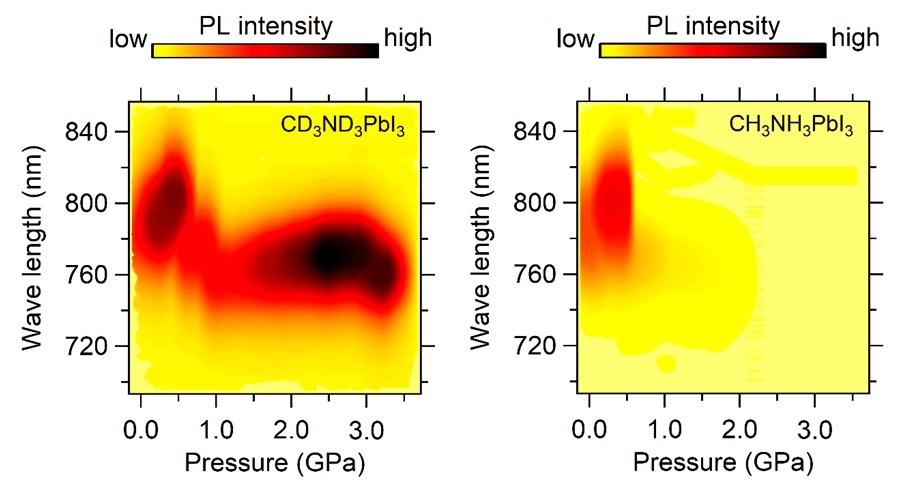The heavier, the better — superior stability in isotope functionalized perovskites - Drs. Gang Liu and Lingping Kong
DECEMBER 4, 2020
New work from a team of scientists led by Drs. Gang Liu and Lingping Kong from HPSTAR employed high pressure tools to discover a significantly suppressed lattice disorder in isotope functionalized perovskite MAPbI3, which is crucial for structural stability and extraordinary optoelectronic properties. Such improved lattice stability boosts its photoluminescence intensity by 3 folds previously unachievable without isotope doping. The result is published recently in Advanced Functional Materials.
Organic-inorganic hybrid lead iodide perovskites are universally recognized as very promising photovoltaic (PV) materials. While outstanding PV performance is continuously reported, manipulating these hybrid perovskites for extraordinary optoelectronic properties with a greater intrinsic structural stability becomes a growing attention. The soft nature of organic–inorganic halide perovskites renders their lattice particularly tunable to external stimuli such as pressure, undoubtedly offering an effective way to modify their structure for extraordinary optoelectronic properties. However, these soft materials meanwhile feature a general characteristic that even a very mild pressure will lead to detrimental lattice distortion and weaken the critical light–matter interaction, thereby triggering the performance degradation.
Herein, an international research team led by scientists from Center for high pressure science and technology advanced research (HPSTAR) reported a comprehensive high-pressure isotope research on hybrid perovskites. To their surprise, it is observed that the pressure-driven lattice disorder can be significantly suppressed via hydrogen isotope effect, which is crucial for better optical and mechanical properties previously unattainable. By in situ neutron/synchrotron-based analysis and optical characterizations, a remarkable photoluminescence (PL) enhancement by threefold is convinced in deuterated CD3ND3PbI3, which also shows much greater structural robustness with retainable PL after high peak-pressure compression–decompression cycle.

The researchers also proposed an atomic level understanding of the strong correlation among the organic sublattice and lead iodide octahedral framework and structural photonics, where the less dynamic CD3ND3+cations are vital to maintain the long-range crystalline order through steric and Coulombic interactions. In addition, the result of device-related investigations shows CD3ND3PbI3-based solar cell has comparable photovoltaic performance as CH3NH3PbI3-based device but exhibits considerably slower degradation behavior, thus representing a paradigm by suggesting isotope-functionalized perovskite materials for better materials-by-design and more stable photovoltaic application.
Caption: Color plots of the pressure-dependent PL evolutions of CD3ND3PbI3 (left) and CH3NH3PbI3 (right) single crystals.
有机无机金属卤化钙钛矿是光电领域重要的活性材料,掌握其全面的结构-物性关系、进而提高器件的功能表现一直是相关领域孜孜追求的目标之一。压力可以连续改变体系的自由能,可以有效、精确地调控材料,系统研究材料的多种关键物理性质。然而,杂化钙钛矿的软性特征使其无法在压力下维系其稳定的晶格,晶体结构无序化和性能劣化在一定的压力阈值后变得不可避免。在本研究中,北京高压科学研究中心刘罡研究员带领的研究团队发现将有机基团内的氢置换为氘后,材料的结构稳定性、功能稳定性、耐压性甚至器件稳定性均有明显提升。这一发现不但为今后功能材料的高压同位素研究提供了一种研究模式,也暗示了功能材料与器件的同位素功能化必然会有进一步发展。相关成果以“Suppressed Lattice Disorder for Large Emission Enhancement and Structural Robustness in Hybrid Lead Iodide Perovskite Discovered by High-Pressure Isotope Effect”发表于近期的《先进功能材料》期刊。论文第一作者为北京高压科学研究中心孔令平研究员。
